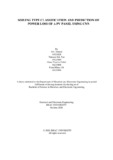| dc.contributor.advisor | Bhuian, Mohammed Belal Hossain | |
| dc.contributor.author | Ahmed, Alvi | |
| dc.contributor.author | Nur, Tahseen Md | |
| dc.contributor.author | Zahid, Omar Tanzim | |
| dc.contributor.author | Ali, Elma Minaz | |
| dc.date.accessioned | 2021-05-24T07:24:18Z | |
| dc.date.available | 2021-05-24T07:24:18Z | |
| dc.date.copyright | 2020 | |
| dc.date.issued | 2020-10 | |
| dc.identifier.other | ID: 14321028 | |
| dc.identifier.other | ID: 19321049 | |
| dc.identifier.other | ID: 16121068 | |
| dc.identifier.other | ID: 16121096 | |
| dc.identifier.uri | http://hdl.handle.net/10361/14426 | |
| dc.description | This thesis is submitted in partial fulfillment of the requirements for the degree of Bachelor of Science in Electrical and Electronic Engineering, 2020. | en_US |
| dc.description | Cataloged from PDF version of thesis. | |
| dc.description | Includes bibliographical references (pages 37-39). | |
| dc.description.abstract | With the rapid advancement of technology, greener and more efficient means for energy
sources are always sought after. Harvesting solar energy is an effective way to generate
electricity. Unfortunately, PV panel surface soiling is a major disruption in energy harvesting
since it massively lowers the ability of the solar panel to be exposed to sunlight. Given how
dire the air pollution situation is in Bangladesh, this is undoubtedly one of the major
problems which have to be addressed when it comes to solar panels setup. When thousands of
solar panels are setup in a remote location in which sunlight is abundantly available, the PV
panel site has to be monitored to check if there are any issues, one of the issues being soiling.
Manually checking thousands of PV panel images for soiling is laborious and time-intensive.
We intend to automate that process using a lightweight deep learning model that can be
incorporated into any system with fairly average computational power. More specifically, our
deep learning model can determine if a particular PV panel is clean or soiled and classify the
type of soiling. It can also make an approximate power loss prediction through image
classification. This process will massively optimize the process of monitoring and negate the
need for manually checking all the PV panels for soiling.
In this paper, we propose the aforementioned deep learning model and discuss in detail how it
has been developed from scratch and how feasible it is | en_US |
| dc.description.statementofresponsibility | Alvi Ahmed | |
| dc.description.statementofresponsibility | Tahseen Md. Nur | |
| dc.description.statementofresponsibility | Omar Tanzim Zahid | |
| dc.description.statementofresponsibility | Elma Minaz Ali | |
| dc.format.extent | 39 pages | |
| dc.language.iso | en_US | en_US |
| dc.publisher | Brac University | en_US |
| dc.rights | Brac University theses are protected by copyright. They may be viewed from this source for any purpose, but reproduction or distribution in any format is prohibited without written permission. | |
| dc.subject | Soiling | en_US |
| dc.subject | Soiling type classification | en_US |
| dc.subject | PV Panel | en_US |
| dc.subject | CNN | en_US |
| dc.title | Soiling type classification and prediction of power loss of a PV panel using CNN | en_US |
| dc.type | Thesis | en_US |
| dc.contributor.department | Department of Electrical and Electronic Engineering, Brac University | |
| dc.description.degree | B. Electrical and Electronic Engineering | |

